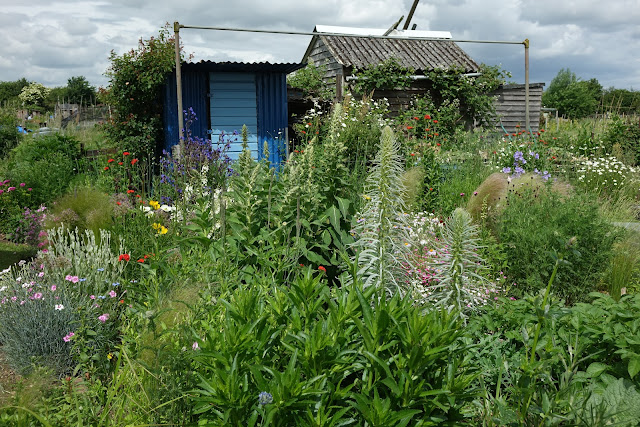 I have my allotment for 7 years now (it is actually 1 full plot and 1 half plot) and it is looking more and more like a garden with many flowers, fruit and vegetables all mixed together. There are no long straight lines of vegetables, I don`t use any pesticides and encourage wildlife to my plot with bee hotels, a pond, two small wildflower meadows, several compost heaps and lots and lots of flowers. I am taking pictures of my plot every month so I thought it will be nice to show these here. I also have a wildlife cam taking videos of wildlife active in the night. See below link to watch some films about the animals I found visiting (or living on) my plot.
I have my allotment for 7 years now (it is actually 1 full plot and 1 half plot) and it is looking more and more like a garden with many flowers, fruit and vegetables all mixed together. There are no long straight lines of vegetables, I don`t use any pesticides and encourage wildlife to my plot with bee hotels, a pond, two small wildflower meadows, several compost heaps and lots and lots of flowers. I am taking pictures of my plot every month so I thought it will be nice to show these here. I also have a wildlife cam taking videos of wildlife active in the night. See below link to watch some films about the animals I found visiting (or living on) my plot.I am also very much into naturalistic planting and really like perennials and ornamental grasses. Most plants you see in my pictures I have grown myself from seed.
If you want to see some moving pictures from my allotment from a few years ago including some more recent wildlife such as the hedgehog regularly visiting my plot have a look here.
This is how it all started in 2010:
The allotment was completely overgrown with up to waist-high weeds and grass.
And this is my allotment in 2017:
The allotment in April (above) with Pasque flowers (Pulsatilla vulgaris, below) flowering.
My little pond at the end of March. There are up to 4 frogs visiting the pond and I find tadpoles every year (pictures below). There are also snails, water boatmen and lots of other little things in the pond. It proves that you don`t need a large pond to attract wildlife.
I have mixed some sand in one of my beds and planted perennials which like poorer and dryer soil (below a picture from March). I also hope to provide some nesting opportunities for ground-nesting solitary bees and wasps.
In May there are Arctic poppies, Verbascums, Nassella tenuissima, Dianthus deltoides and Aster tongolensis `Wartburgstern` flowering (pictures below). I have added some more species now so it will be interesting what it looks like next year.
Oriental poppies always add a splash (below).
I grow sweet peas every year but from June onward they are full of pollen beetles so I only enjoy them on the allotment then.
June was quite dry this year and I had to water every week but I have planted more drought-tolerant perennials this year as we seem to get these prolonged dry spells more often now.
The area near the shed will be the most colourful on the allotment later, with some Echium wildpretii (in the middle, picture below) adding an exotic touch.
Here is Echium wildpretii in flower (below). I bought the seeds on Tenerife, Canary Islands, where it grows wild in Mount Teide National Park.
Summer is always a very colourful time on the allotment with many taller perennials coming into flower. Heliopsis helianthoides var. scabra with Echinops ritro (below).
The cold frame is nearly disappearing between all the flowers (below).
In July, Echinacea purpurea is opening its flowers, one plant I am always looking forward to (below).
The allotment in August (below), a riot of colours.
Butterflies such as this gatekeeper like the Echinacea flowers (below).
Naturalistic planting with grasses, Cirsium tuberosum, Kniphofia, yarrow, Verbena bonariensis and Eupatorium purpureum in September (pictures below).
Lovely dark-purple New England aster (Aster novi-angliae, below). I have planted some Rudbeckia fulgida var. deamii close to it so I hope for some nice colour contrasts next year.
In September many of the late asters are opening their flowers. They look pretty together with ornamental grasses. Bumblebees and butterflies love the flowers. (pictures below)
One of my favourite plants are Kniphofias. I started a little collection now, collecting different species and cultivars. This is Kniphofia `Pineapple Popsicle` (below).
Kniphofia `Mango Popsicle` looks beautiful planted next to Stipa calamagrostis and flowers for most of the summer (below).
A view from the back of the allotment. The tree in the background is a very tasty greengage with large very sweet and juicy fruit (below).
Helenium autumnalis and Eupatorium purpureum with runner beans in the background (below). Yes, I grow vegetables as well! :-).
I hope you enjoyed this little introduction of my plot. I intend to post pictures of my plot every month so you can see how it develops. I have planted (and still have many more to plant) lots of new perennials this autumn. I am also on the waiting list for another allotment as I still have so many ideas such as a prairie meadow, a bog garden, another pond, more steppe/dry planting and much more but I am starting to run out of space now on my current plot.
See you soon with a blog post about my allotment in winter.





































No comments:
Post a Comment